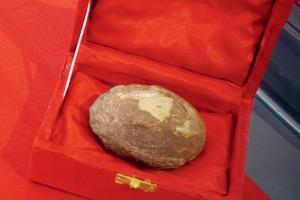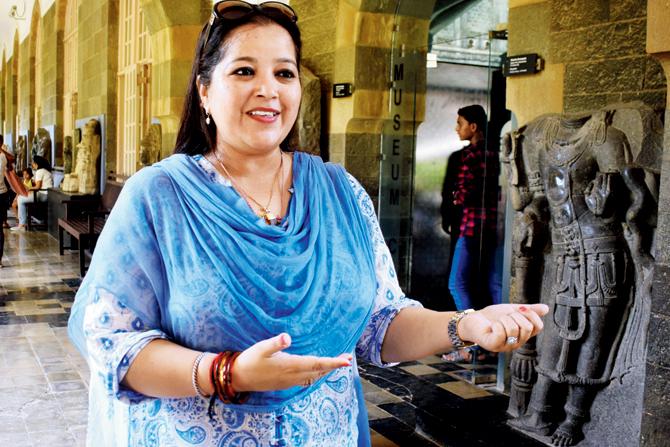Princess Aaliya Sultana Babi of Balasinor aka India's Dinosaur Princess, on a visit to Mumbai, talks of her introduction to palaeontology, the importance of public awareness and being a Jurassic Park fan

In the Natural History section of the Chhatrapati Shivaji Maharaj Vastu Sangrahalaya (CSMVS), children flock by a display casing placed at the centre of the space. Walking into a room filled with specimens, you know that something here is real. And you can understand their fascination when the flexboard reads, "Fossilized dinosaur eggs and bones discovered in India on view at the CSMVS for the first time." The little collection has come from Balasinor, Gujarat — one of the largest dinosaur fossil sites in the world. We then meet the person responsible for this collaborative initiative. Princess Aaliya Sultana Babi – whose ancestry can be traced back to Sher Khan Babi, an officer in service of Mughal emperor Humayun – has helmed conservation efforts in the region.
Edited excerpts from the interview.

A child looks at the display comprising of parts of a dinosaur rib, chunk of a sauropod's lower limb, a theropod egg, the famous masala egg and part of a vertebrae. Pics/Ashish Raje
When did your fascination with dinosaurs begin?
My mother tells me an interesting anecdote from my childhood. I was around four years old and she hired a teacher to teach me basic English and arithmetic before I was shipped off to a boarding school. So instead of learning D for Dog, I was learning D for Dinosaur. And this was at a time when none of us knew that there was a dinosaur excavation site very much in our backyard. At that age, I could spell Brontosaurus and Diplodocus. So, maybe it was my calling.
When I went to boarding school, I completely forgot about dinosaurs. After I returned, I had nothing to do. Coming from an orthodox family, I couldn't go to a city to study or work. At that time, yes, just out of boredom, I started accompanying tourists to the excavation site in Balasinor. I had zero knowledge then, so, when tourists asked me questions, I would draw a blank. That was when I decided to educate myself on the subject if I want tourists to go back happy. I then started collecting data and literature from paleontologists who used to visit the site. Now it's been a 22-year-old journey, full of ups and downs and here's an interesting fact — I'm an English literature student, I didn't study paleontology.

Princess Aaliya Sultana Babi of Balasinor
Which is a misconception -- that you can't delve into a scientific field without having studied it...
Yes, it was difficult for me to understand the paleontology terms — talking of sauropods and theropods. But I was very successful because I had a lot of paleontologists who became my friends, like Dr Mahabey who founded the site and Jeff Wilson from the University of Michigan. Even today he answers all my questions. So, even though I read Merchant of Venice and Romeo and Juliet in college, I'm talking about geosciences today. It's indeed a misconception when people say, 'You can't do this.' I think I'm the biggest example; I'm a self-taught paleontologist with 22 years of experience.
Tell us about the time you discovered a theropod egg.
We found it with a village woman who was using it to grind her masala. She did not know it was a fossilised egg, she thought it was just a rock. When we discovered it, it was all covered with chilly and that was the time I gave it a very loving name — masala egg.
How did the exhibit in Mumbai come about?
We had Manoj Chaudhari (assistant curator, natural sciences at CSMVS) come and visit our site. He put this idea (of bringing the fossils to the city) to me and I agreed. I hope to have a long association with CSMVS so we can have more exhibits and sessions.
But how do you see the profession evolving?
Paleontology is coming up in a very big way — every second tourist that I get, the child wants to be a paleontologist. Which is nice because in my age group, we have none. The senior generation have all retired so there's this gap now. So, the younger ones are the hope for the future. India holds a very important place in this field — our country was part of the Gondwana land where we were attached to Africa and Antartica, which most of us don't know. India also plays a crucial role in the extinction of dinosaurs with the Deccan volcanism. That is why I now try to hold sessions like this one at CSMVS where I try to educate the public on what India is — one of the lands which is the fourth oldest in the world.
What are some of the immediate threats to conservation?
There is a problem of theft. A lot of vandalism is taking place. We need to educate the public on how to preserve fossils. You see, at first the fossil site was completely open. We managed to get around 52 hectares barricaded and we have also done the same with all the individual fossils that are there in the open. Now we're getting lots of visitors — around 1,000 per day when we're not officially open. So people are becoming aware that this is something we want to look at. As and when people do a tour with me, I try to explain paleontology. Otherwise, for the layman, it is just rocks.
You're a fan of the Jurassic Park movies. What are your thoughts on its scientific accuracy?
Our site in Balasinor is not a Jurassic Park [as commonly known]. I would call it a Cretaceous Park because the fossils found here belong to that age. But the movie, from what I have seen and read, is 75 to 80 per cent accurate because Steven Spielberg had hired a professional as his consultant. But a lot of research has taken place since then. So what the T-Rex looked like then is going to be very different from what it is going to look like now. If he is going to make a sequel to the old ones, I'm sure we'll see a very different version of the T-Rex, probably a feathered one -- because the latest research says so, not that they flew but they definitely had feathers.
Catch up on all the latest Mumbai news, crime news, current affairs, and also a complete guide on Mumbai from food to things to do and events across the city here. Also download the new mid-day Android and iOS apps to get latest updates
 Subscribe today by clicking the link and stay updated with the latest news!" Click here!
Subscribe today by clicking the link and stay updated with the latest news!" Click here!









